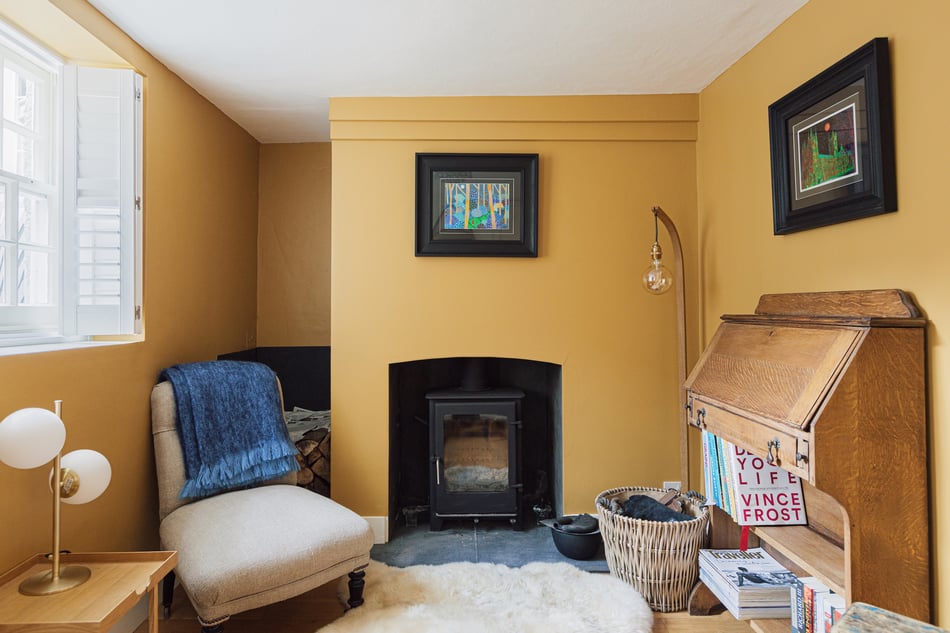
The Deal Lugger is a Grade II-listed three-bedroom house, located on a quiet street a short stroll from the seafront. Situated in the heart of Deal’s old town, it lies within the Deal Middle Street conservation area – the first designated conservation area in the whole of Kent. The house was built in 1820 in the vernacular style and for most of its life operated as a local ‘beer shop’, named after the famous Deal Lugger boats that operated from the nearby shingle beach. The house has recently undergone a sympathetic and extensive restoration; the owners carefully retained its original features and, where lost, reinstated replacements. Internal accommodation extends to almost 1,200 sq ft and is painted exclusively in Farrow & Ball’s muted shades. Plantation shutters feature at fenestration to all street-facing rooms and there is a private south-facing courtyard garden to the rear.
Setting the Scene
The Deal Lugger is perfectly equidistant to the fashionable High Street and the seafront, enjoying the facilities of both yet peacefully located on a quiet connecting street. The house has a charming appearance from street level, rendered in pretty pale green stucco with a Kentish clay peg tile hipped roof, eight/eight box sash windows and a central dormer window at its apex. The original storm porch, conceived to protect entry to the house from westerly winds coming up from the beach, acts as a welcome antechamber on wintery days. A secondary entry door remains unused, though is left as a subtle reminder of the home’s former commercial use. For more information on Deal itself, please see the History section below.
The Grand Tour
Entry is immediately to the generous living room, where handsome wainscotting lends a gracious air to the space. The panelling is painted chalky white and oak floorboards run underfoot. The open hearth features an overmantle in the early-Georgian style, which could be reinstated to introduce an open working fire. A wide-set architrave opens to a secondary sitting room and cosy ‘snug’, painted ‘India Yellow’ and centred around a warming log burner.
The kitchen lies at the rear of the house and is characterised by a high-set pitched roof lantern, which allows the room to be flooded with light. A run of limestone flooring connects the kitchen and garden beyond through large tripartite oak-framed folding glass doors, creating an effortless flow between interior and exterior spaces. Oiled oak surfaces sit atop simple pale stone colour panelled cupboards, and there is a butler sink and range cooker. A wine rack is cleverly accommodated above the entire length of wall cupboards to the rear. A separate guest cloakroom and utility room with concealed mirror spaces above and behind are discreetly set to the side; these spaces provide the opportunity for further development, subject to planning permission.
The first floor has two bedrooms and two bathrooms, with the main bedroom at the front of the plan. This room has a bullseye chimneypiece with a rare cast-iron Kent grate set within, and a beautiful original exposed wall of plank boards separating the sleeping quarters from the en suite bathroom. The remaining plastered walls are painted in the pinkish hues of ‘Setting Plaster’. The bathroom has a freestanding roll-top bath and separate shower enclosure, with walls clad in Carrara marble metro tiles from Fired Earth. The second bedroom currently also acts as a study and features cupboards that are original to the house; it is served by a separate shower room.
The third bedroom is in the garret at the apex of the house and set into the pitch of the roof; a peaceful room, it has wonderful views of the surrounding rooftops. A wall of plank door storage offers plentiful wardrobing, and fenestration set into both the east and west aspects allow this room to enjoy the very best light from sunrise to sunset.
The Great Outdoors
The charming courtyard garden is something of a sun trap, south-facing with paved limestone underfoot and convenient separate side access to Farrier Street. Entered directly through folding glass doors from the kitchen, it acts as an external living room in warmer months, perfect for drinks or languorous summer lunches alfresco. The evening light is particularly magical.
Out and About
The Deal Lugger is equidistant to the seafront and the High Street; each less than a minute’s walk away. Deal Castle Beach and famed Deal Pier, the last fully intact leisure pier remaining in Kent, are incredibly popular with the local community. The Rose Hotel is known for its excellent bar and restaurant, as is the Frog & Scot. Real Deal Roasters is a renowned coffee supplier and shop, Arno & Co the preferred grocers and Merchant of Relish the favoured deli. The Black Pig butchers and Jenkins & Sons fishmongers are also both noteworthy. There is also a fantastic Saturday farmers’ market selling local produce.
The High Street has many other independent antique, clothes, and homewares stores. Of particular note, and just a short walk away, is the ever-popular lifestyle and homewares emporium Green & Found. Built in the early 1800s within the Captain’s Gardens at Deal Castle, it provides creative spaces for local craftspeople to work, and also offers workshops, talks and events. Other local attractions include the famed Deal Castle, nearby Walmer Castle, and slightly further afield, Sandwich Bay and St Margaret’s Bay.
Sandwich, Dover and Canterbury are all easily accessed by car, via the A2 and A258. High-speed trains run from Deal to London St Pancras with a total journey time of 84 minutes, with alternative direct trains to London Charing Cross and London Bridge. Access to the continent is also excellent via the Port of Dover, the Channel Tunnel at Folkestone and Eurostar from Ashford International.
Council Tax Band: E
History
Deal was first mentioned in the Domesday Book. By the end of the 13th century, it had become a ‘limb port’ of the larger Cinque Ports nearby, and at one time was the busiest port in England. Its rich maritime history is complemented by its role as a key garrison town, as well as having a noted mining, fishing, and perhaps less salubriously, rich smuggling heritage.
After its role as a resort town declined in the late 20th century, Deal has experienced a great renaissance as something of an artistic haven in recent years, with people attracted by the beautiful historic architecture within the town, the creative community and excellent independent provisors that centre around the High Street, and its position on the beautiful Kent coastline.
Interested? Let’s talk
Related Listings
- Coastal Collective: five beautiful boltholes a stone’s throw from ocean sprayHomes
- Great and Small: five exceptional cottages worth dreaming aboutHomes
- Historic Heights: six distinctly noteworthy homes, Grade II*-listed and aboveHomes
- A Private View: a self-taught vintage cognoscente shares the lessons learnt during her first renovationHomes / Interiors
- A Private View: the artful home of Robin Welch, the celebrated ceramicist who broke the mouldHomes / Interiors

